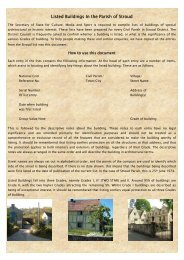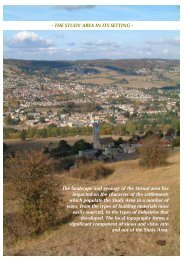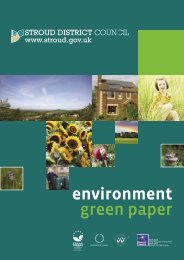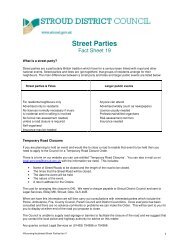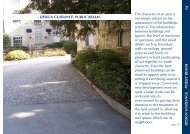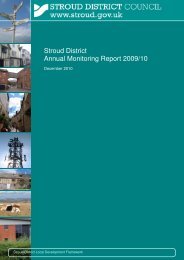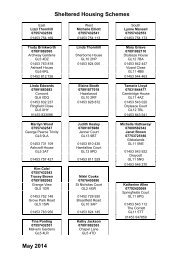CONSERVATION AREA STATEMENT - Stroud District Council
CONSERVATION AREA STATEMENT - Stroud District Council
CONSERVATION AREA STATEMENT - Stroud District Council
You also want an ePaper? Increase the reach of your titles
YUMPU automatically turns print PDFs into web optimized ePapers that Google loves.
28<br />
<strong>CONSERVATION</strong> <strong>AREA</strong> <strong>STATEMENT</strong> - Conservation Area No7: FRAMPTON ON SEVERN<br />
The Buildings in Sub Area 2: The Street<br />
Early buildings and materials<br />
Some of the earliest surviving buildings in Frampton on Severn are to be found on The Street. Wildgoose Cottage,<br />
The Old Thatch, The Summerhouse and Greycroft date from the latter half of the 15th century and De Lacy Hall/The<br />
Old Cruck House was built in the early 16th century.<br />
These cottages are all of timber, cruck frame construction, an ancient method of building. Put simply, cruck framed<br />
buildings are generally rectangular and divided into sections, or ’bays’ by pairs of naturally curving timbers, ‘cruck<br />
blades’, cut from a single trees, usually oak or elm. These rise from a stone plinth, right up, and join together at the<br />
top to form the apex of the roof. Wooden struts, attached using wooden pegs, tie the timbers in place and the spaces<br />
between the timbers are infilled with wattle and daub, then plastered over.<br />
The original wattle and daub can be seen in the gable end of Greycroft and above the windows at De Lacy Cottage.<br />
These are relatively rare survivals as much was lost to later brick infilling.<br />
<strong>Stroud</strong> <strong>District</strong> <strong>Council</strong>



